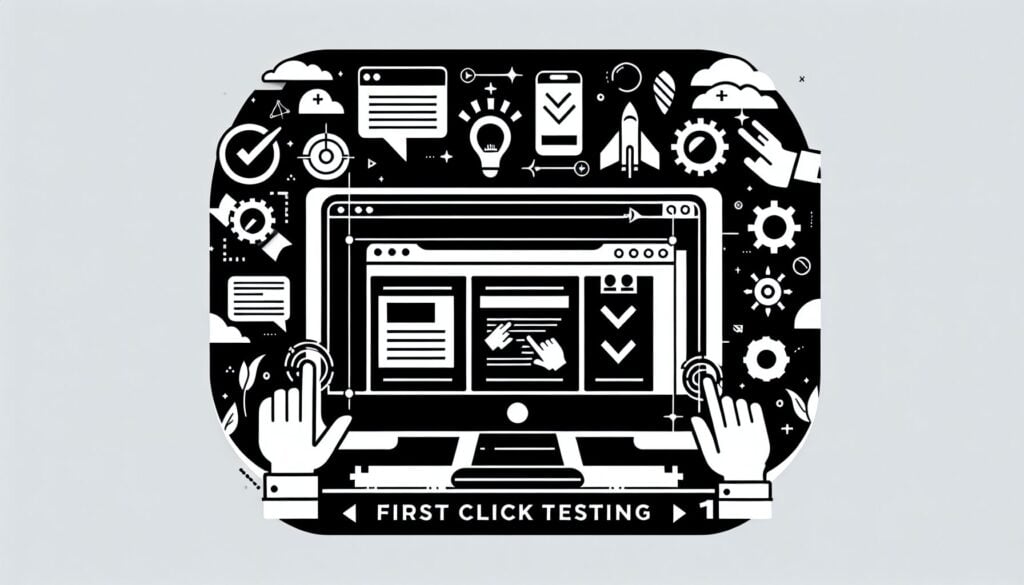A usability testing method that evaluates the effectiveness of a website’s navigation and architettura dell'informazione by tracking where a user would click first to complete a specific task.
- Metodologie: Economia, Lean Sigma, Produzione, Risoluzione dei problemi, Qualità
Test del primo clic

Test del primo clic
- Pensiero progettuale, Architettura dell'informazione, Design dell'interazione, Usabilità, Test di usabilità, Esperienza utente (UX), Interfaccia utente (UI), Test dell'utente, Progettazione incentrata sull'utente
Obiettivo:
Come si usa:
- Ai partecipanti viene assegnato un compito e mostrata l'immagine di una pagina web (o di un prototipo). Viene chiesto loro di fare clic sul punto in cui andrebbero per primo per cercare di completare il compito. Vengono registrate le percentuali di successo e le posizioni dei clic.
Professionisti
- È veloce e poco costoso da condurre; può essere realizzato con wireframe o mockup, anche prima dello sviluppo; fornisce indicazioni chiare sulla capacità degli utenti di trovare ciò che cercano.
Contro
- Testa solo il primo passo di un'attività, non l'intero flusso; non fornisce informazioni qualitative sul motivo per cui gli utenti fanno clic (a meno che non sia combinato con altri metodi); la progettazione dell'attività è fondamentale.
Categorie:
- Progettazione del prodotto
Ideale per:
- Valutare l'efficacia della navigazione e dell'etichettatura dei link vedendo dove gli utenti cliccano per primi per completare un'attività.
First Click Testing serves a vital function in user experience evaluation, particularly during the early phases of product design such as concept development and user interface design. This methodology is frequently utilized in industries such as e-commerce, software development, and mobile app creation, where effective web navigation is paramount to customer satisfaction and engagement. During usability studies, participants are only shown a static image of a webpage or prototype rather than a fully functional site, which allows for rapid testing before development begins. This provides product teams with real-time feedback on how users interpret labeling of links and navigation structures. Teams often involve product managers, UX designers, and researchers to analyze click data efficiently—information that can inform interface adjustments before more extensive testing is conducted. By identifying common click areas and understanding if users are directed toward the right content, companies can enhance their designs iteratively, minimizing costly reworks after launch. With the procedure being low-cost and approachable for small scale testing, various design iterations can be evaluated quickly, ensuring that the final product aligns with user expectations. Empirical data collected enables teams to advocate for design changes based on user behavior rather than assumptions, making the testing method a foundational element of data-driven design strategies.
Fasi chiave di questa metodologia
- Define a specific task for users related to the webpage or prototype.
- Present users with an image of the webpage or prototype.
- Ask users to click on the area they believe is the first step to complete the task.
- Record the click location and whether the user successfully identifies where to go.
- Analyze the click data to assess navigation effectiveness and link labeling.
Suggerimenti per i professionisti
- Incorporate demographic segmentation in participant selection to uncover varying user behaviors and expectations.
- Conduct iterative rounds of testing to progressively refine the design based on earlier findings and to address emerging issues.
- Combine click data with qualitative feedback through follow-up questions to understand the rationale behind participants' choices.
Leggere e confrontare diverse metodologie, raccomandiamo il
> Ampio archivio di metodologie <
insieme ad altre 400 metodologie.
I vostri commenti su questa metodologia o ulteriori informazioni sono benvenuti su sezione commenti qui sotto ↓ , così come tutte le idee o i link relativi all'ingegneria.
Contesto storico
1986
(se la data non è nota o non è rilevante, ad esempio "meccanica dei fluidi", viene fornita una stima approssimativa della sua notevole comparsa)

Post correlati
Programma di produzione principale (MPS)
Personalizzazione di massa
Imbuto di marketing
Audit di marketing
Indice MAPO (Movimento e assistenza dei pazienti in ospedale)
Pianificazione delle risorse di produzione (MRP II)